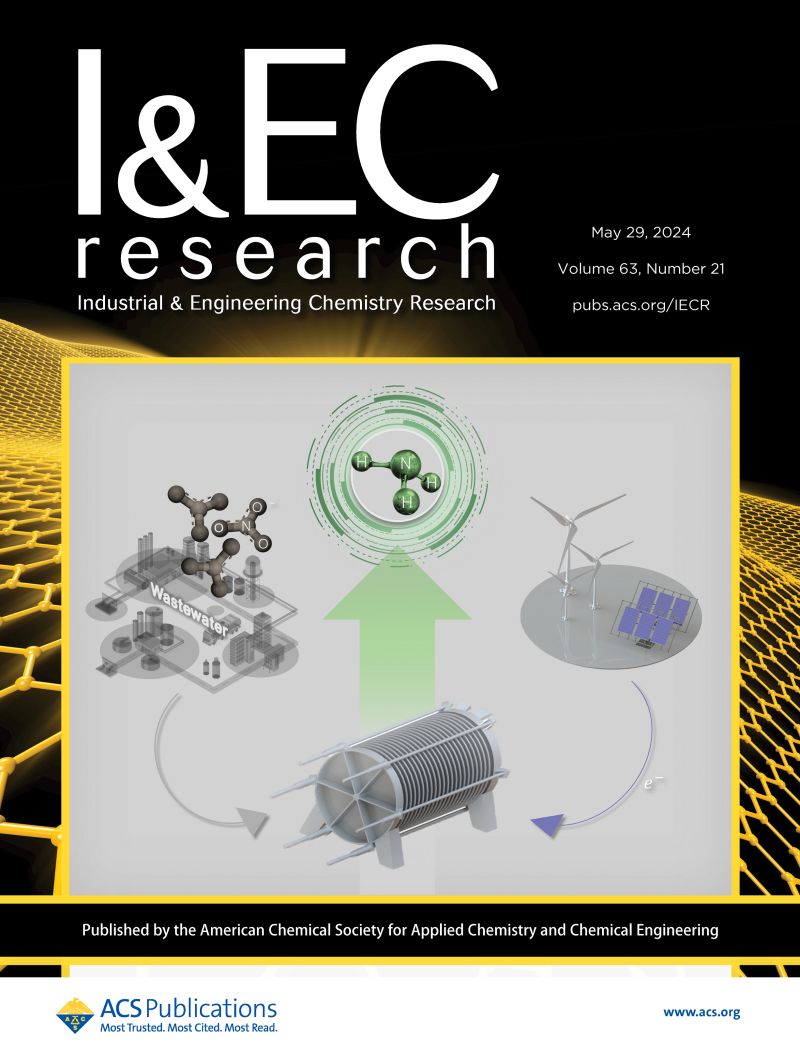基于计算流体力学与实验设计相结合的多效真空膜蒸馏模块优化设计
IF 3.9
3区 工程技术
Q2 ENGINEERING, CHEMICAL
引用次数: 0
摘要
多效膜蒸馏(MD)是一种能够有效降低MD工艺能耗的工艺,在废水浓缩与减量领域具有广阔的工业应用前景。因此,开发适合多效蒸馏工艺的膜组件至关重要。本文将计算流体力学(CFD)与实验设计(DOE)相结合的方法引入到多效应VMD模块的多目标优化设计中,系统地研究了结构变量之间的相互关系及其耦合效应对模块性能的影响。首先,建立了三维CFD模型,计算传质通量(Jv)、增益输出比(GOR)和渗透进料比(ϕp),并在实验室规模的VMD系统中对CFD模型进行了实验验证。基于Box-Behnken响应面法(BBD响应面法),以VMD模块的进口位置、膜面长度和通道高度为可变因素进行CFD模拟,得到不同变量组合的响应值。结果表明,进口位置和通道高度是影响Jv的主要因素,通道高度是影响GOR和ϕp的主要因素。基于这些结果,建立了预测Jv、GOR和ϕp的回归方程,为实际VMD模块设计提供了重要指导。通过应用所开发的模型,优化了VMD模块的结构尺寸,从而同时提高了热效率和水生产率。这些结果为在工业规模的多效应VMD系统中部署优化模块奠定了理论基础。本文章由计算机程序翻译,如有差异,请以英文原文为准。

Optimal Design of Multieffect Vacuum Membrane Distillation Modules Based on the Combination of Computational Fluid Dynamics and Design of Experiments
Multieffect membrane distillation (MD) is a process that can effectively reduce the energy consumption of the MD process, and it has broad industrial application prospects in the field of concentration and reduction of wastewater. Therefore, it is crucial to develop optimum membrane modules suitable for the multieffect distillation process. This study introduces a computational fluid dynamics (CFD) and design of experiments (DOE) integrated approach for the multiobjective optimization design of multieffect VMD modules, systematically investigating the interrelationships between structural variables and their coupled effects on module performance. First, a three-dimensional CFD model was established to calculate mass transfer flux (Jv), gain output ratio (GOR), and permeate-to-feed ratio (ϕp), and the CFD model was validated experimentally in a lab-scale VMD system. Based on the Box-Behnken response surface method (BBD response surface method), the inlet position, membrane surface length, and channel height of VMD modules were taken as variable factors to perform CFD simulation, and the response values of different variable combinations were obtained. The results show that inlet position and channel height are the main factors influencing Jv, and channel height is the main factor influencing GOR and ϕp. Based on these results, regression equations were developed to predict Jv, GOR, and ϕp, providing critical guidance for practical VMD module design. By application of the developed models, the structural dimensions of VMD modules were optimized to achieve concurrent improvements in both thermal efficiency and water productivity. These results establish a theoretical basis for deploying the optimized module in industrial-scale multieffect VMD systems.
求助全文
通过发布文献求助,成功后即可免费获取论文全文。
去求助
来源期刊

Industrial & Engineering Chemistry Research
工程技术-工程:化工
CiteScore
7.40
自引率
7.10%
发文量
1467
审稿时长
2.8 months
期刊介绍:
ndustrial & Engineering Chemistry, with variations in title and format, has been published since 1909 by the American Chemical Society. Industrial & Engineering Chemistry Research is a weekly publication that reports industrial and academic research in the broad fields of applied chemistry and chemical engineering with special focus on fundamentals, processes, and products.
 求助内容:
求助内容: 应助结果提醒方式:
应助结果提醒方式:


